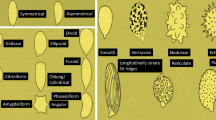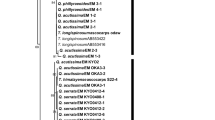Abstract
The first commercialization of seedlings inoculated with truffle fungi occurred in 1973. Over the last 40 years, considerable progress has been made relative to quality control for inoculated seedlings. A recently published paper by Andrés-Alpuente and colleagues (Mycorrhiza 24:29–37, 2014) reviewed and tested the different methods of mycorrhization assessment currently used in Europe. The aim of this paper is to augment their findings by adding information to the discussion about the most important steps in seedling quality control. Additionally, the history of seedlings inoculated with truffles, procedures currently used in France for seedling control quality, and a reflection on future research aimed at increasing truffle production will be presented.

Similar content being viewed by others
References
Andrés-Alpuente A, Sánchez S, Martín M, Aguirre J, Barriuso J (2014) Comparative analysis of different methods for evaluating evergreen oaks mycorrhized with black truffle. Mycorrhiza 24(1 supplement):29–37
Antony-Babu S, Deveau A, Van Nostrand JD, Zhou J, Le Tacon F, Robin C, Frey-Klett P, Uroz S (2014) Black truffle-associated bacterial communities during the development and maturation of Tuber melanosporum ascocarps and putative functional roles. Environmental Microbiology. doi:10.1111/1462-2920.12294
Belfiori B, Riccioni C, Paolocci F, Rubini A (2013) Mating type locus of Chinese Black Truffles reveals heterothallism and the presence of cryptic species within the T. indicum species complex. PLoS One 8(12):e82353
Bonito GM, Gryganskyi AP, Trappe JM, Vilgalys R (2010) A global meta-analysis of Tuber ITS rDNA sequences: species diversity, host associations and long-distance dispersal. Molecular Ecology 19(22): 4994–5008
Bonito GM, Trappe JM, Donovan S, Vilgalys R (2011) The Asian black truffle Tuber indicum can form ectomycorrhizas with North American host plants and complete its life cycle in non-native soils. Fungal Ecol 4(1):83–93
Bonito GM, Smith ME, Nowak M, Healy RA, Guevara G, Ca¡zares E, Kinoshita A, Nouhra ER, Dominguez LS, Tedersoo L, Murat C, Wang Y, Moreno BA, Pfister DH, Nara K, Zambonelli A, Trappe JM, Vilgalys R (2013) Historical biogeography and diversification of truffles in the Tuberaceae and their newly identified southern hemisphere sister lineage. PLoS One 8(1):e52765
Boutahir S, Iotti M, Piattoni F, Zambonelli A (2013) Morphological and molecular characterization of Tuber oligospermum mycorrhizas. Afr J Agric Res 8(29):4081–4087
Chevalier G, Grente J (1979) Application pratique de la symbiose ectomycorhizienne: production à grande échelle de plants mycorhizés par la truffe. Mushr Sci 10:483–505
Contessi A (2013) Disciplinare di produzione delle piante micorizzate con tartufo certificate. http://bur.regione.emilia-romagna.it/dettaglio-inserzione?i=3c203c17842f95ac2b9d3899a302f49d
Fassi B, Fontana A (1967) Sintesi micorrizica tra Pinus strobus e Tuber maculatum. I. Micorrize e sviluppo dei semenzali nel secondo anno. Allionia 13:177–186
Fassi B, Fontana A (1969) Sintesi micorrizica tra Pinus strobus e Tuber maculatum. II. Sviluppo dei semenzali trapiantati e produzione di ascocarpi. Allionia 15:115–120
Fontana A (1967) Sintesi micorrizica tra Pinus strobus e Tuber maculatum. Giorn Bot Ital 101:298–299
Fontana A, Fasolo Bonfante P (1971) Sintesi micorrizica di Tuber brumale Vitt. con Pinus nigra Arnold. Allionia 17:15–18
Fontana A, Palenzona M (1969) Sintesi micorrizica di Tuber albidum in coltura pura, con Pinus strobus e pioppo euroamericano. Allionia 19:99–104
Garcia–Montero LG, Di Massimo G, Manjón JL, García–Cañete J (2008) Effect of Sphaerosporella brunnea mycorrhizas on mycorrhization of Quercus ilex × Tuber Melanosporum. N Z J Crop Hortic Sci 36(3):153–158
Guerin-Laguette A, Cummings N, Hesom-Williams N, Butler R, Wang Y (2013) Mycorrhiza analyses in New-Zealand truffières reveal frequent but variable persistence of Tuber melanosporum in co-existence with other truffle species. Mycorrhiza 23(2):87–98
Hall IR, Haslam W (2012) Truffle cultivation in southern hemisphere. In A. Zambonelli and G.M. Bonito (eds), Edible Ectomycorrhizal Mushrooms, Soil Biology 34, doi:10.1007/978-3-642-33823-6_11
Jeandroz S, Murat C, Wang Y, Bonfante P, Le Tacon F (2008) Molecular phylogeny and historical biogeography of the genus Tuber, the ‘true truffles’. J Biogeogr 35(5):815–829
Le Tacon F, Zeller B, Plain C, Hossann C, Bréchet C, Robin C (2013) Carbon transfer from the host to Tuber melanosporum mycorrhizas and ascocarps followed using a C pulse-labelling technique. Plos one 8(5):e64626
Le Tacon F, Mousain D, Garbaye J, Bouchard D, Churin JL, Argillier C, Amirault JM, Généré B (1997) Mycorhizes, pépinières et plantations forestières en France. Revue Forestière Française, n° spécial mycorhizes, XLIX:131-154
Le Tacon F, Marçais B, Courvoisier M, Murat C, Becker M (2014) Climatic variations explain annual fluctuations in French Périgord black truffle wholesale markets but does not explain the decrease in black truffle production over the last 48 years. Mycorrhiza 24(1 supplement):115–125
Lee G, Ong Cho S, Benali S (2014) Quality aspects of the Australian black truffle. 1st International conference on truffle research ’14. Vic (Spain), 9-12 March 2014
Mello A, Fontana A, Meotto F, Comandini O, Bonfante P (2001) Molecular and morphological characterization of T. magnatum mycorrhizas in a long-term survey. Microbiol Res 155:279–284
Murat C, Vizzini A, Bonfante P, Mello A (2005) Morphological and molecular typing of the below-ground fungal community in a natural Tuber magnatum truffle-ground. FEMS Microbiol Lett 245:307–313
Murat C, Zampieri E, Vizzini A, Bonfante P (2008) Is the Perigord black truffle threatened by an invasive species? We dreaded it and it has happened! New Phytol 178(4):699–702
Murat C, Rubini A, Riccioni C, De La Varga H, Akroume E, Guaragno M, Le Tacon F, Robin C, Halkett F, Martin F, Paolocci F (2013) Fine scale spatial genetic structure of the black truffle (Tuber melanosporum) investigated with neutral microsatellites and functional mating type genes. New Phytologist 199(1):176–187
Olivier JM, Savignac JC, Sourzat P (2012) Truffe et trufficulture. Fanlac, Périgueux
Palenzona M (1969) Sintesi micorrizica tra Tuber aestivum Vitt., Tuber brumale Vitt., Tuber melanosporum Vitt. E semenziali di Coryllus avellana. Allionia 15:122–131
Palenzona M, Chevalier G, Fontana A (1972) Sintesi micorrizica tra i miceli in coltura di T. brumale, T. melanosporum, T. rufum e semenzali di conifere e latifoglie. Allionia 18:41–52
Rubini A, Paolocci F, Granetti B, Arcioni S (2001) Morphological characterization of molecular-typed Tuber magnatum ectomycorrhizae. Mycorrhiza 11:179–185
Sisti D, Giomaro G, Rocchi M, Zambonelli A, Romagnoli E, Gregory G (2008) Nuove prospettive nel controllo delle piante micorrizate con tartufo. Third Congresso Internazionale di Spoleto sul Tartufo, November 22- 28 novembre 2008, Spoleto, Italy
Zambonelli A, Iotti M, Piattoni F (2012) Chinese Tuber aestivum sensulato in Europe. Open Mycol J 6:22–26
Zhang JP, Liu PG, Chen J (2012) Tuber sinoaestivum sp. nov., an edible truffle from southwestern China. Mycotaxon 122(10):73–82
Acknowledgments
I would like to thank Dr. Randy Molina for giving me the opportunity to prepare this commentary paper as well as for the help in the manuscript preparation. I would also like to thank Dr. Francis Martin and Dr. François Le Tacon for their stimulating discussions and their help in preparing this manuscript and Aimée Orsini for the English correction. Also highly appreciated was the discussion with Prof. Alessandra Zambonelli. I am grateful to Dr. Gérard Chevalier for teaching me about seedling control and for having shared with me his 40-year experience working with truffles at INRA. I also thank Dr. Carlos Colinas and Dr. Herminia De La Varga for their help. Lastly, thanks to Damien Berlureau and Bruno Robin for allowing me to present the seedling rate criteria used in the Chevalier and Grente methods as well as statistics since 1973 on commercialized seedlings. The UMR1136 is supported by a grant overseen by the French National Research Agency (ANR) as part of the “Investissements d’Avenir” program (ANR-11-LABX-0002-01, Lab of Excellence ARBRE), by ANR SYSTERRA SYSTRUF (ANR-09-STRA-10), and by the Lorraine Region.
Author information
Authors and Affiliations
Corresponding author
Rights and permissions
About this article
Cite this article
Murat, C. Forty years of inoculating seedlings with truffle fungi: past and future perspectives. Mycorrhiza 25, 77–81 (2015). https://doi.org/10.1007/s00572-014-0593-4
Received:
Accepted:
Published:
Issue Date:
DOI: https://doi.org/10.1007/s00572-014-0593-4




